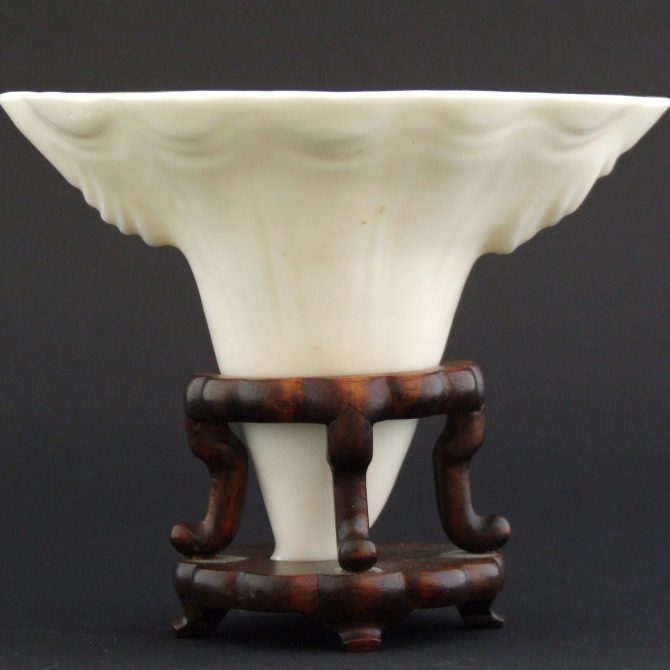
CHONGZHEN to SHUNZHI c.1640 – 1660 Blanc de Chine Porcelain
An Unusual Blanc de Chine Porcelain `Rhinoceros` Horn Cup, Late Ming or Early Qing Dynasty, Chongzhen to Shunzhi c.1640-1660. Dehua Kilns, Fujian Province. With a Later Wood Stand.
SOLD
- Condition
- The rim polished
- Size
- Length : 12.5 cm (4 3/4 inches)
- Provenance
- N/A
- Stock number
- 23761
- References
- or a blanc de chine porcelain cup of this form but with applied decoration of figures see: Blanc de Chine, Porcelain From Dehua, A Catalogue of the Hickley Collection, Singapore (Rose Kerr & John Ayers, Art Media Resources Ltd, 2002) Item 127, and for one with prunus see 126. For a Blanc de Chine cup of this form described as a "Wedding Cup" of "True Rhinoceros" form see : Blanc de Chine (P.J. Donnelly, Faber and Faber, 1969. ISBN 571-08078-2) plate 24a. For another cup of this form see : Blanc de Chine, Divine Images in Porcelain (John Ayres, China Institute Gallery, New York, 2002) page 68, plate 19. For a further Blanc de Chine cup of this form : Blanc de Chine, Divine Images in Porcelain (John Ayres, China Institute Gallery, New York, 2002) For other blanc de chine cups in the form a full Rhinoceros horn see our `Sold Items` numbers 17872 19129, and 22939.
Information
`Rhinoceros` Horn Blanc de Chine Cups :
Rhino horn has a beautiful translucent colour when carved, and from as far back as the Tang Dynasty the Chinese have made ornamental cups and other carvings. One of the more useful purposes of the horn of the Rhinoceros was that when it was made into a drinking cup it was said to have the power to detect poisons. It is thought that this may have been because many early poisons were strong alkaloids that may have reacted strongly with the keratin and gelatin in the rhino horn, thereby indicating the presence of poison. Cups made of this material were also connected with fertility, the ground horn is used in Chinese medicine as an aphrodisiac, so by association drinking from the cup made of Rhino horn or a porcelain one of that shape might help with the bringing of children. This connection is enhanced by Donnelly who points out that a Rhinoceros cup bares an inscription relating to a wedding. Blanc de Chine cups modelled in the form of a full Rhinoceros horn are rare, nearly all shaped Blanc de Chine cups are based on a Rhino horn with the point removed and a decorative base applied. When one looks at the porcelain cups modelled as the whole horn it becomes clear the solid point was lutted on, in other words these cups was made in two parts.